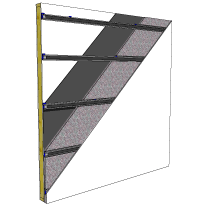Soundproofing Existing Walls

Before you jump into trying out different methods of soundproofing it s essential to understand how soundproofing works.
Soundproofing existing walls. For best soundproofing results you should consider removing your existing wall or ceiling and start the sound control process from your studs as detailed in our how to soundproof article. When it comes to the best ways to soundproof your existing walls we have compiled a list so you can adequately judge all their pros cons. However if you prefer to keep your walls and ceilings in place and are content with a solid upgrade about 6 9 stc points then we have outlined the proper. Install your wall soundproofing materials on the side of the wall from which the noise is coming.
Deadening those vibrations is best done with heavy dense materials that stop noise in its. How to add soundproof insulation inside the wall. Soundproofing new or existing walls involves adding mass behind the walls and or something that absorbs and dissipates sound waves. If you want to soundproof your existing interior walls insulation is one of your best friends.
Add a second layer of drywall over existing interior walls to increase the thickness and weight of the wall. Important principles of soundproofing existing walls. Blowing insulation into existing wall spaces can and will make the walls more sound proof and prevent noise from getting in and out of the room. To quiet household noise you ll need to reduce vibrations plug sound leaks and absorb sounds.
That way you can use the solutions you think are a better fit for your current issue. Especially if you like to switch things up in your home every now and then this won t be a problem. Switch things up by rearranging the furniture. The green glue is a viscoelastic material and it can be used as a low frequency sound barrier.
Tips and advice for soundproofing walls include. By soundproofing your walls you ll gain peace and quiet and restore a little sanity to your household. This material takes up to 30 days to reach its maximum performance. Heavier walls with greater mass are typically more soundproof than their thin counterparts.
9 easy and cheap ways to soundproof existing walls 1. Install the quiet barrier hd onto the wall surface with roofing nails 1 inch in size. In other words if your kids or neighbor are making all the racket. Best ways in 2020.
If you don t want to spend any money you can stop some noise passing through the walls by simply rearranging your furniture. Locate the studs in the wall with a stud finder. Mark them with chalk.














































